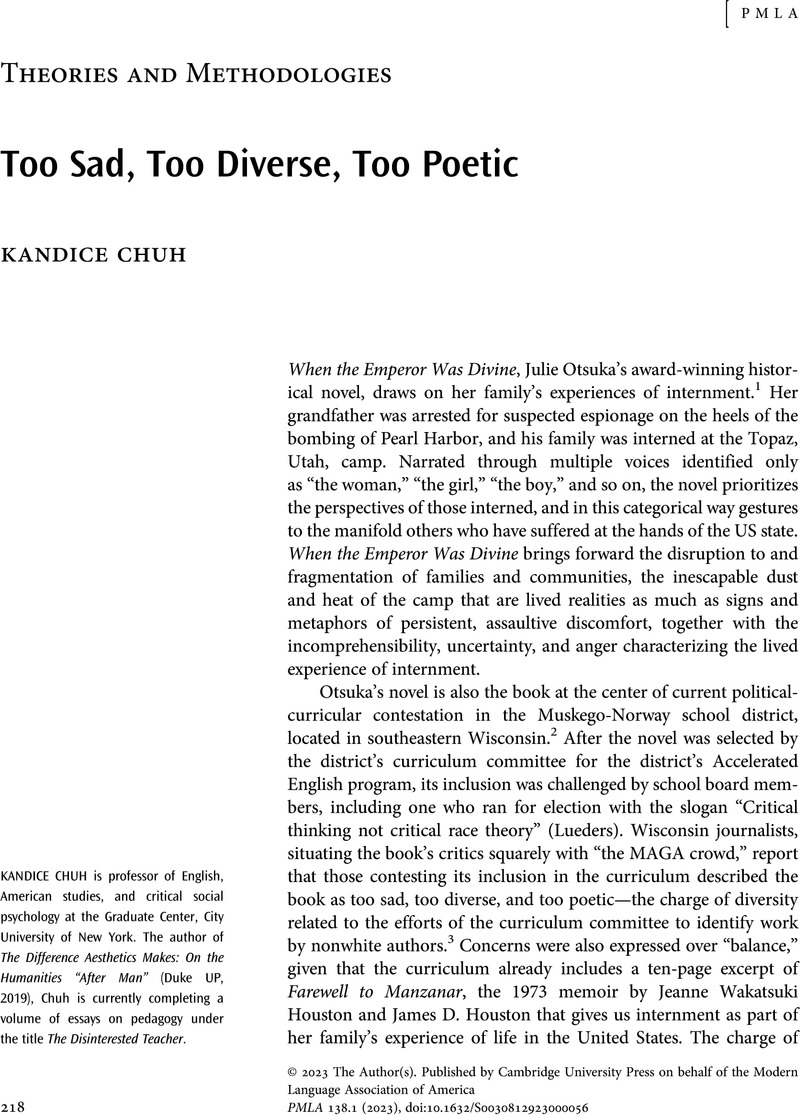No CrossRef data available.
Article contents
Too Sad, Too Diverse, Too Poetic
Published online by Cambridge University Press: 07 March 2023
Abstract
An abstract is not available for this content so a preview has been provided. Please use the Get access link above for information on how to access this content.

- Type
- Theories and Methodologies
- Information
- Copyright
- Copyright © 2023 The Author(s). Published by Cambridge University Press on behalf of the Modern Language Association of America
References
Works Cited
“Banned and Challenged Books.” American Library Association, www.ala.org/advocacy/bbooks. Accessed 4 Aug. 2022.Google Scholar
Byrd, Jodi A. The Transit of Empire: Indigenous Critiques of Colonialism. U of Minnesota P, 2011.CrossRefGoogle Scholar
Coulthard, Glen Sean. Red Skins, White Masks: Rejecting the Colonial Politics of Recognition. U of Minnesota P, 2014.CrossRefGoogle Scholar
Ferguson, Roderick. The Reorder of Things: The University and Its Pedagogies of Minority Difference. U of Minnesota P, 2012.CrossRefGoogle Scholar
Friedman, Jonathan, and Johnson, Nadine Farid. “Banned in the USA: Rising School Book Bans Threaten Free Expression and Students’ First Amendment Rights.” PEN America, 2022, pen.org/banned-in-the-USA/.Google Scholar
Houston, Jeanne Wakatsuki, and Houston, James D.. Farewell to Manzanar. Houghton Mifflin, 1973.Google Scholar
Hughes, Langston. “The Negro Artist and the Racial Mountain.” Within the Circle: An Anthology of African American Literary Criticism from the Harlem Renaissance to the Present, edited by Mitchell, Angelina, Duke UP, 1994, pp. 55–59.Google Scholar
Linnane, Rory. “Muskego Educators Stopped from Teaching Book about WWII Incarceration of Japanese Americans.” Milwaukee Journal Sentinel, 30 June 2022, www.jsonline.com/story/news/education/2022/06/30/muskego-educators-stopped-teaching-book-wwii-incarceration-japanese-americans/7756407001/.Google Scholar
Linnane, Rory. “Wisconsinites Rally around Book Rejected by Muskego Board for Focus on Japanese Experience.” Milwaukee Journal Sentinel, 19 July 2022, www.jsonline.com/story/news/education/2022/07/18/rally-backs-book-rejected-muskego-focus-japanese-americans/10051434002/.Google Scholar
Lueders, Bill. “Wisconsin School District Rejects Book about Japanese Internment.” Wisconsin Examiner, 22 June 2022, wisconsinexaminer.com/2022/06/22/Wisconsin-school-district-rejects-book-about-Japanese-internment/.Google Scholar
Melamed, Jodi. Represent and Destroy: Rationalizing Violence in the New Racial Capitalism. U of Minnesota P, 2011.CrossRefGoogle Scholar


